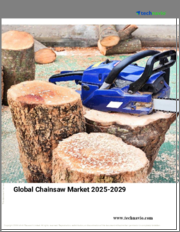
|
시장보고서
상품코드
1666066
세계의 체인톱 시장 규모, 점유율, 성장 분석 : 전력별, 바 길이별, 용도별, 안전 기능별, 지역별 - 산업 예측(2025-2032년)Chainsaw Market Size, Share, and Growth Analysis, By Power Source (Electric, Gasoline), By Bar Length (Less than 16 inches, 16 to 20 inches), By Application, By Safety Features, By Region - Industry Forecast 2025-2032 |
||||||
전기톱 시장 규모는 2023년 41억 달러로 평가되었고, 예측 기간(2025-2032년) 동안 3.7%의 연평균 복합 성장률(CAGR)로 2024년 42억 5,000만 달러에서 2032년에는 56억 9,000만 달러로 성장할 것으로 예상됩니다.
전기톱 시장은 지속적인 기술 발전과 건설 분야 수요 증가, 선진국의 전기자동차 보급이 그 원동력이 되고 있습니다. 제조업체들은 가스식, 전기식, 배터리식 등 제품 라인을 다양화하여 가정용과 상업용 모두에 대응하고 있습니다. 과거에는 나무를 베거나 삼림 벌채와 같은 무거운 작업에서 유용성을 인정받아 가솔린 구동식 전기톱이 주류를 이루었습니다. 그러나 친환경 솔루션으로의 전환으로 인해 배터리식 및 전기 모델이 부상하고 있습니다. 전기자동차나 공장 콘센트에서 전원을 공급받는 전기 전기톱은 사용 편의성과 낮은 배기가스 배출량으로 인기를 끌고 있습니다. 배터리 구동 옵션은 환경에 미치는 영향이나 연료 보급 비용 없이 가스 모델과 동등한 기능을 제공하여 시장 확대를 주도하고 있습니다.
목차
서론
- 조사 목적
- 조사 범위
- 정의
조사 방법
- 정보 조달
- 2차와 1차 데이터 방법
- 시장 규모 예측
- 시장 전제조건과 제한
주요 요약
- 세계 시장 전망
- 공급과 수요 동향 분석
- 부문별 기회 분석
시장 역학과 전망
- 시장 개요
- 시장 규모
- 시장 역학
- 성장 촉진요인과 기회
- 성장 억제요인과 과제
- Porter의 Five Forces 분석
주요 시장 인사이트
- 중요 성공 요인
- 경쟁 정도
- 주요 투자 기회
- 시장 생태계
- 시장의 매력 지수(2024년)
- PESTEL 분석
- 거시경제 지표
- 밸류체인 분석
- 가격 분석
- 사례 연구
- 고객과 구매 기준 분석
체인톱 시장 규모 : 전력별&CAGR(2025-2032년)
- 시장 개요
- 전기
- 가솔린
- 배터리
체인톱 시장 규모 : 바 길이별&CAGR(2025-2032년)
- 시장 개요
- 16인치 미만
- 16-20인치
- 20인치 이상
체인톱 시장 규모 : 용도별&CAGR(2025-2032년)
- 시장 개요
- 주택
- 상업
- 산업
체인톱 시장 규모 : 안전 기능별&CAGR(2025-2032년)
- 시장 개요
- 자동 체인 브레이크
- 킥백 방지 브레이크
- 체인 윤활 시스템
체인톱 시장 규모&CAGR(2025-2032년)
- 북미
- 미국
- 캐나다
- 유럽
- 독일
- 스페인
- 프랑스
- 영국
- 이탈리아
- 기타 유럽
- 아시아태평양
- 중국
- 인도
- 일본
- 한국
- 기타 아시아태평양
- 라틴아메리카
- 브라질
- 기타 라틴아메리카
- 중동 및 아프리카
- GCC 국가
- 남아프리카공화국
- 기타 중동 및 아프리카
경쟁 정보
- 주요 5개사 비교
- 주요 기업의 시장 포지셔닝(2024년)
- 주요 시장 기업이 채택한 전략
- 최근 시장 동향
- 기업의 시장 점유율 분석(2024년)
- 주요 기업 개요
- 기업 상세
- 제품 포트폴리오 분석
- 기업 부문별 점유율 분석
- 매출 전년대비 비교(2022-2024)
주요 기업 개요
- Makita U.S.A. Inc(U.S.)
- STIHL(Germany)
- Hitachi Ltd.(Japan)
- Zhejiang Zomax Garden Machinery(China)
- Robert Bosch GmbH(Germany)
- Husqvarna Group(Netherlands)
- ECHO Incorporated(U.S.)
- Remington Arms Company, L.L.C.(U.S.)
- Craftsman(U.S.)
- QVTOOLS(U.S.)
결론과 제안
LSH 25.04.03Chainsaw Market size was valued at USD 4.1 billion in 2023 and is poised to grow from USD 4.25 billion in 2024 to USD 5.69 billion by 2032, growing at a CAGR of 3.7% during the forecast period (2025-2032).
The chainsaw market is on a growth trajectory, fueled by ongoing technological advancements and increasing demand from the construction sector and electric vehicle adoption in developed nations. Manufacturers are diversifying their product lines to include gas, electric, and battery-operated chainsaws, catering to both household and commercial needs. Historically, gasoline-powered chainsaws dominated, recognized for their utility in heavy-duty tasks like tree felling and deforestation. However, the shift towards eco-friendly solutions has led to a rise in battery-operated and electric models. These electric chainsaws, powered by electric vehicles or factory outlets, are gaining popularity for their ease of use and lower emissions. Battery-operated options provide comparable functionality to gas models without the environmental impact or refueling costs, driving market expansion.
Top-down and bottom-up approaches were used to estimate and validate the size of the Chainsaw market and to estimate the size of various other dependent submarkets. The research methodology used to estimate the market size includes the following details: The key players in the market were identified through secondary research, and their market shares in the respective regions were determined through primary and secondary research. This entire procedure includes the study of the annual and financial reports of the top market players and extensive interviews for key insights from industry leaders such as CEOs, VPs, directors, and marketing executives. All percentage shares split, and breakdowns were determined using secondary sources and verified through Primary sources. All possible parameters that affect the markets covered in this research study have been accounted for, viewed in extensive detail, verified through primary research, and analyzed to get the final quantitative and qualitative data.
Chainsaw Market Segments Analysis
Global Chainsaw Market is segmented by Power Source, Bar Length, Application, Safety Features and region. Based on Power Source, the market is segmented into Electric, Gasoline and Battery. Based on Bar Length, the market is segmented into Less than 16 inches, 16 to 20 inches and 20 inches and above. Based on Application, the market is segmented into Residential, Commercial and Industrial. Based on Safety Features, the market is segmented into Automatic chain brake, Anti-kickback brake and Chain lubrication system. Based on region, the market is segmented into North America, Europe, Asia Pacific, Latin America and Middle East & Africa.
Driver of the Chainsaw Market
The expansion of the chainsaw market is significantly influenced by the escalating rates of urbanization and deforestation driven by infrastructural projects. As cities grow, there is a heightened demand for wood-based materials such as flooring, panels, and roofing, largely motivated by improving living standards and a growing focus on interior design. Additionally, the surge in consumer spending on premium hardwood furniture is further bolstering the demand for chainsaws in furniture manufacturing processes. This combination of factors is creating a robust environment for chainsaw market growth, as both construction and furniture industries rely heavily on the efficient processing of timber.
Restraints in the Chainsaw Market
The global chainsaw market faces significant restraints due to heightened concerns about environmental protection and safety. The reliance on gas-powered chainsaws leads to increased carbon emissions, which poses a challenge in regions prioritizing sustainability and eco-friendliness. As governments implement stricter emission regulations, there is a noticeable shift towards battery-powered alternatives. Additionally, safety concerns, including the potential for accidents and injuries associated with chainsaw usage, further complicate market dynamics. These factors collectively hinder market growth and compel both manufacturers and consumers to explore environmentally friendly and safer options within the chainsaw industry.
Market Trends of the Chainsaw Market
The chainsaw market is witnessing a significant trend fueled by the rapid advancement of lithium-ion battery technology. The increasing demand for lightweight, efficient, and high-performance chainsaws has led manufacturers to prioritize the development of lithium-ion powered models. These batteries not only provide longer operational time and faster charging but also contribute to reduced emissions, appealing to environmentally conscious consumers. As advancements continue, industry players are focusing on enhancing battery life and performance, accommodating a wider range of applications, from professional forestry to residential use. This shift is expected to drive the growth of battery-powered chainsaws, revolutionizing the market landscape.
Table of Contents
Introduction
- Objectives of the Study
- Scope of the Report
- Definitions
Research Methodology
- Information Procurement
- Secondary & Primary Data Methods
- Market Size Estimation
- Market Assumptions & Limitations
Executive Summary
- Global Market Outlook
- Supply & Demand Trend Analysis
- Segmental Opportunity Analysis
Market Dynamics & Outlook
- Market Overview
- Market Size
- Market Dynamics
- Drivers & Opportunities
- Restraints & Challenges
- Porters Analysis
- Competitive rivalry
- Threat of substitute
- Bargaining power of buyers
- Threat of new entrants
- Bargaining power of suppliers
Key Market Insights
- Key Success Factors
- Degree of Competition
- Top Investment Pockets
- Market Ecosystem
- Market Attractiveness Index, 2024
- PESTEL Analysis
- Macro-Economic Indicators
- Value Chain Analysis
- Pricing Analysis
- Case Studies
- Customer And Buying Criteria Analysis
Global Chainsaw Market Size by Power Source & CAGR (2025-2032)
- Market Overview
- Electric
- Gasoline
- Battery
Global Chainsaw Market Size by Bar Length & CAGR (2025-2032)
- Market Overview
- Less than 16 inches
- 16 to 20 inches
- 20 inches and above
Global Chainsaw Market Size by Application & CAGR (2025-2032)
- Market Overview
- Residential
- Commercial
- Industrial
Global Chainsaw Market Size by Safety Features & CAGR (2025-2032)
- Market Overview
- Automatic chain brake
- Anti-kickback brake
- Chain lubrication system
Global Chainsaw Market Size & CAGR (2025-2032)
- North America (Power Source, Bar Length, Application, Safety Features)
- US
- Canada
- Europe (Power Source, Bar Length, Application, Safety Features)
- Germany
- Spain
- France
- UK
- Italy
- Rest of Europe
- Asia Pacific (Power Source, Bar Length, Application, Safety Features)
- China
- India
- Japan
- South Korea
- Rest of Asia-Pacific
- Latin America (Power Source, Bar Length, Application, Safety Features)
- Brazil
- Rest of Latin America
- Middle East & Africa (Power Source, Bar Length, Application, Safety Features)
- GCC Countries
- South Africa
- Rest of Middle East & Africa
Competitive Intelligence
- Top 5 Player Comparison
- Market Positioning of Key Players, 2024
- Strategies Adopted by Key Market Players
- Recent Developments in the Market
- Company Market Share Analysis, 2024
- Company Profiles of All Key Players
- Company Details
- Product Portfolio Analysis
- Company's Segmental Share Analysis
- Revenue Y-O-Y Comparison (2022-2024)
Key Company Profiles
- Makita U.S.A. Inc (U.S.)
- Company Overview
- Business Segment Overview
- Financial Updates
- Key Developments
- STIHL (Germany)
- Company Overview
- Business Segment Overview
- Financial Updates
- Key Developments
- Hitachi Ltd. (Japan)
- Company Overview
- Business Segment Overview
- Financial Updates
- Key Developments
- Zhejiang Zomax Garden Machinery (China)
- Company Overview
- Business Segment Overview
- Financial Updates
- Key Developments
- Robert Bosch GmbH (Germany)
- Company Overview
- Business Segment Overview
- Financial Updates
- Key Developments
- Husqvarna Group (Netherlands)
- Company Overview
- Business Segment Overview
- Financial Updates
- Key Developments
- ECHO Incorporated (U.S.)
- Company Overview
- Business Segment Overview
- Financial Updates
- Key Developments
- Remington Arms Company, L.L.C. (U.S.)
- Company Overview
- Business Segment Overview
- Financial Updates
- Key Developments
- Craftsman (U.S.)
- Company Overview
- Business Segment Overview
- Financial Updates
- Key Developments
- QVTOOLS (U.S.)
- Company Overview
- Business Segment Overview
- Financial Updates
- Key Developments
















